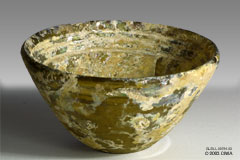Grooved bowl, Syro-Palestine, 150-50 BC

Links to other views:⇒ Larger Viewif scripting is off, click the ⇒ instead. Links to others from Ptolemaic PeriodBronze ithyphallic god Bes, PtolemaicBronze of Eros, Ptolemaic, 200-100 BC Bronze of Mut, Ptolemaic Period Bronze statuette of Aphrodite, Ptolemaic Bronze Venus, Alexandria, 50 BC-50 AD Gold and cornaline necklace, Alexandria Gold ring, Ptolemaic Period, 304-30 BC Horus-the-Child, Alexandria, 100-30 BC Horus-the-Child, Alexandria, 304-30 BC Horus-the-Child, Ptolemaic, 200-100 BC Horus-the-Child, Ptolemaic, 304-30 BC Horus-the-Child riding a swan, 304-31 BC Tall bronze Osiris, Ptolemaic Period Links to others of type BowlBronze bowl, Sasanian Persia, 224-650 ADBronze bowl with ibexes, Luristan, 900-700 BC Bronze bowl with omphalos, Persia, 559-334 BC Bronze bowl with omphalos, Persia, 559-500 BC Double-convex bowl, Roman, 100-200 AD Early-dynastic alabaster bowl, 3100-2686 BC Large glass bowl, Roman world Large silver bowl, Sasanian Persia, 226-637 AD Ribbed bronze bowl, Persia, 559-334 BC Ribbed glass bowl, Alexandria, 50 BC-50 AD Sigillated bowl, Roman Gaul, 100-150 AD |
This transparent olive green glass cup is thick walled (6-8 mm thick). It was most probably produced by sagging, probably upside down over a convex mold, as the wall gets thicker towards the rim. The bottom presents three deep concentric cut grooves on the external face. The inside presents three deep parallel and equidistant cut grooves near the rim. The rim appears to have been ground to an ogival profile. Syro-palestinian, mid-second to early first century BC. Cracked. Thick white weathering crust. Some pitting. Parallels: Ernesto Wolf Collection, # 79. “Syro-Palestinian grooved bowl. Eastern Mediterranean, probably Syro-Palestinian. Mid second to early first century BC. Height 9.9 cm; Diameter rim 15.4 cm; average Thickness wall 0.6 cm. Translucent natural olive green glass. A few pinprick bubbles. Made from a monochrome blank; sagged; cut on interior and exterior; traces of rotary scratches on interior, top of rim, and upper half of exterior wall. Complete; two small cracks between the grooves; large area of iridescent buff white weathering on interior. Conical bowl. Upright rim with round edge, sloping obliquely outward; straight sides, tapering diagonally downward; convex bottom. On the interior, six horizontal grooves cut in three bands of two each on the upper half of the body; on the exterior, a horizontal band of two cut grooves around the bottom, and one small circular groove at the center of the underside. This bowl belongs to a characteristic group of grooved bowls made on the Syro-Palestinian coast from the mid second to early first century BC. By far the largest concentration of finds, fragments of over six thousand grooved bowls came to light at Tel Anafa in north Israel, in Upper Galilee. Fragments of grooved bowls have been excavated at numerous sites throughout the Mediterranean, from as far east as Dura Europos in Syria… Grooved bowls are closely related to three other types of bowls thought to have been made on the Syro-Palestinian coast: fluted bowls, ribbed bowls and linear-cut bowls. The earliest datable grooved bowls were found in the Athenian Agora, dated shortly before 150 BC. Grooved bowls appear to have gone out of production in the first half of the first century BC” (Stern and Schlick-Nolte 1994:284-285 #79). “Conical bowl. Ht 8.8 cm; mouth dia. 14 cm. Pale yellow-green glass bowl, cast. A specimen of a popular Hellenistic type with three wide wheel-cut lines on the upper section of the interior. The piece is covered with substantial patches of brownish encrustation and some creamy weathering crust. Also present are some strain cracks which are frequently encountered in such cast vessels. Hellenistic, 2nd - 1st century BC” (Fortuna 1991:12-13 #17). Bibliography (for this item)Fortuna Fine Arts, Ltd.,1991 Shining Vessels: Ancient Glass from Greek, Roman, and Islamic Times. Fortuna Fine Arts, Ltd., New York, NY. (12-13 # 17) Stern, E. Marianne, and Birgit Schlick-Nolte 1994 Early Glass of the Ancient World 1600 BC - AD 50 Ernesto Wolf Collection. Gerd Hatje, Ostfildern, Germany. (284-285 # 79) |